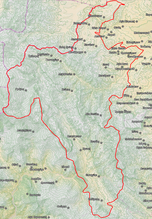Nestorio
|
Nestorio Νεστόριο |
|
|---|---|
 |
|
| Coordinates: 40°24′N 21°3′E / 40.400°N 21.050°ECoordinates: 40°24′N 21°3′E / 40.400°N 21.050°E | |
| Country | Greece |
| Administrative region | West Macedonia |
| Regional unit | Kastoria |
| Area | |
| • Municipality | 616.1 km2 (237.9 sq mi) |
| • Municipal unit | 336.3 km2 (129.8 sq mi) |
| Highest elevation | 1,700 m (5,600 ft) |
| Lowest elevation | 900 m (3,000 ft) |
| Population (2011) | |
| • Municipality | 2,646 |
| • Municipality density | 4.3/km2 (11/sq mi) |
| • Municipal unit | 1,411 |
| • Municipal unit density | 4.2/km2 (11/sq mi) |
| Community | |
| • Population | 964 (2011) |
| Time zone | EET (UTC+2) |
| • Summer (DST) | EEST (UTC+3) |
| Postal code | 520 51 |
| Vehicle registration | AT |
Nestorio (Greek: Νεστόριο, Nestório; Macedonian: Нестрам (Nestram); Bulgarian: Нѐсрам (Nesram)) is a village and a municipality in the Kastoria regional unit of Macedonia, Greece. Nestorio is a small picturesque village 28 km southwestwards of Kastoria, at the banks of the river Aliakmon.
The village is particularly famous for its annual late-July rock festival, River Party. River Party started in 1978. Most people camp out on specially prepared grounds in the forest near the stage. The bands come from the Greek rock scene, especially from Athens and Thessaloniki and with foreign guests, including from the wider region. Visitors also participate in extreme games including archery and rafting.
The municipality Nestorio was formed at the 2011 local government reform by the merger of the following 4 former municipalities, that became municipal units:
The municipality has an area of 616.072 km2, the municipal unit 336.326 km2.
The municipal unit of Nestorio is divided into the following communities:
The area was ruled by the Ottoman Empire until the Balkan Wars of 1912-13, in the late 19th and early 20th century as part of Manastir Vilayet. Nestorio had 2,700 inhabitants in the beginning of the 20th century and most of them were slavophone (Slavic speaking) orthodox Christians and a few of them Vlachs. In the early 20th century the majority of the inhabitants of Nestorio accepted the rule of the Bulgarian Exarchate. According to the statistics of Vasil Kanchov (Macedonia. Ethnography and Statistics) the inhabitants of Nestorio in 1900 were Bulgarians. Nestorio, along with the rest of southern Macedonia, was incorporated into Greece in 1913 following the Balkan Wars.
...
Wikipedia


